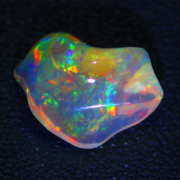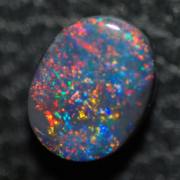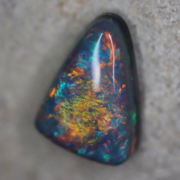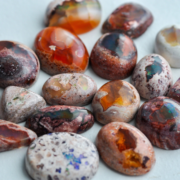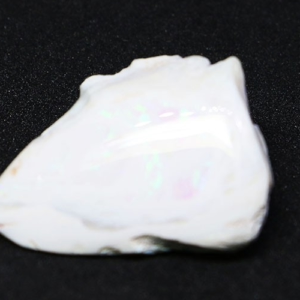Opal stone – properties, virtues & benefits
Opal stone is a gem with shimmering reflections that captivate the eye. It is prized for its unique beauty and rarity, and is often used in jewelry to create dazzling jewels. Discover the characteristics and properties of this fascinating stone.
OPAL CHARACTERISTICS
- Chakra: Crown, Throat.
- Properties: Stone of transformation, stimulates creativity and imagination, promotes communication, self-confidence and emotional healing.
- Astrology: Uranus.
- Zodiac: Cancer, Libra, ScorPio and Pisces.
- Elements: Water.
- Colors: Multicolored, often with blue, green and red highlights.
- Hardness: 5.5-6.5 on the Mohs scale.
- Chemical Formula: SiO2-nH2O.
- Associated god: None.
OPALE – ITS HISTORY
The history of opal goes back far beyond that of humans and spans the globe. The word “opal” comes from the Sanskrit “Upala” meaning “precious stone”. The name was taken up in Latin as “Opalus” and in Greek as “Opallios”, both meaning “to see a change of color”.
Objects decorated with opal have been discovered in a cave in Kenya dating back to 4,000 BC. Opal has been mined in North America’s Virgin Valley for 10,000 years.
Various cultures have associated weather-related legends with opal. The Aborigines called it the “rainbow serpent” because the creator god is said to have gathered this spectrum of colors to create the stone. In India, the goddess of the rainbow is said to have transformed herself into opal to escape her many suitors, who were captivated by her beauty. Finally, in Arab culture, opal is said to result from lightning light trapped in rock.
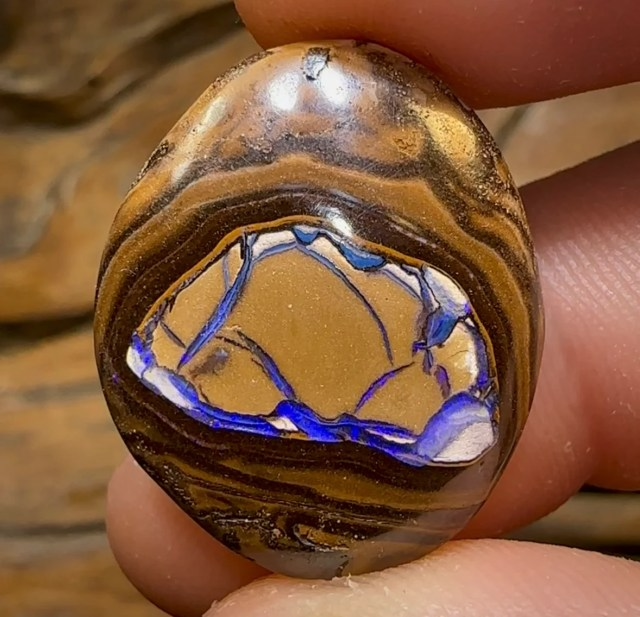
.
In ancient Greece, opal is said to have been born in the eyes of the king of the gods, Zeus. His tears of joy following his triumph over the Titans are said to have turned to opal on contact with the ground. Since then, the Greeks have attributed powers of clairvoyance and prophecy to opal, a belief echoed in the Middle Ages when it was renamed “ophthalmios” (eye stone) in consideration of its virtues for the eyes.
.
Finally, among the Romans, opal was a symbol of hope and purity. They would have been the first to market it, arousing covetousness. Marc Antony is said to have banished a senator who refused to sell him an opal intended for Cleopatra, estimated today at 60,000 euros.
.
Among the world’s most famous and expensive gems are:
- The OlymPic Australis Opal, named after the Melbourne OlymPics when it was discovered, retains its rough form and weighs 17,000 carats, making it worth up to $2,500,000.
- The Andamooka opal weighs 203 carats and was presented to Queen Elizabeth II, set on a pendant surrounded by diamonds.
- L’Incendie de Troie, a 700-carat black opal estimated at 50,000 euros, disappeared after the Second World War.
- The Queen’s Fire, with a mass of 900 carats, comes from the Angledool mines in Australia.
- Aurore Australis is the most precious black opal, weighing 180 carats and valued at one million Australian dollars.
OPAL STONE – ITS ORIGIN AND COMPOSITION
Opal is formed by alternating wet and dry periods. PreciPitation transports various elements, including silica, which accounts for over 60% of the mass of the earth’s continental crust, into groundwater via the phenomenon of erosion. An aqueous chemical reaction called hydrolysis causes silica to react with other impurities to form opal. When a new dry period occurs, the upper layers of chalcedony and quartz, from which opal is extracted, form as a result of evaporation. Due to the small, unpredictable size of the silica deposit, opal mining is artisanal. The main deposits are found in Oceania and America, but also in other parts of the world.
.
Discovered in Australia in 1849, opal is found in layers of sandy clay deposited in the Cretaceous period by the sea that covered the depressions forming the Great Artesian Basin. Opal production began in 1890 in New South Wales and Queensland. Today, 75% of opals come from the Coober Pedy fields, which stretch over 70 kilometers and were discovered in the 1920s.
Until 2007, opal was considered a mineral, but it’s actually composed of several elements, including cristobalite, tridymite and hydrated amorphous silica, as well as a variable percentage of water, depending on the variety. Its crystalline structure is its main characteristic, the quality of opal being determined by the purity of its crystals, which create the iridescent reflections. The play of colors is due to the diffraction of light, resulting from the random arrangement of microscoPic plates of tridymite or cristobalite spheres. There are two basic varieties of opal: common opal, which has no play of color, and noble opal, a type of highly transparent quartz that is considered a fine stone and used in jewelry.
“Harlequin” opal features an extremely rare distribution of colors, similar to the checkered suit of the same name, but its ground color can be black, white or boulder. However, this does not qualify it as a distinct opal variety.
There are several varieties of opal, distinguished by their origin, background color or the nature of the gem. Varieties include:
- Alumocalcite
- Diatomite
- La fiorite
- La forchérite
- Hydrophane
- L’isopyre
- Mascareignite
- Menilitis
- Neslite, which is light and tender and can float on water
- Opals by deposition
- White opal
- Australian opal
- Fire opal, which can vary in hue from transparent to yellow-orange or red, and does not always show a play of colors
- Black opal
- Pink opal
- Green opal
- Golden opal
- The quincite

OPAL STONE – VERTIES AND PROPERTIES
OPAL ON THE PSYCHOLOGICAL LEVEL
Lithotherapy uses crystals to act on energies and chakras. The water contained in opal dissolves energy barriers linked to beliefs and fears of lack, and restores the free flow of energies. It helps to awaken consciousness, let go and live in the present moment. Each opal variety has its own vibration and aims at different asPirations.
Common opal, which vibrates at a gentler intensity than transparent and fire opals, has calming and soothing effects on the emotional body. Sensitive people or those under excessive stress will particularly benefit from its effects. Noble opal has a powerful effect on energy balance. EthioPian opal is used to treat disorders of the nervous system, mental and nervous instability, and sadness in the root, heart and coronal chakras. It acts as a mirror reflecting inner visions, facilitates astral travel and stimulates dreams. Andean opal heals emotional wounds.
Also, the choice of colors should not be overlooked. White opal is used to face our inner life. A symbol of purity of feeling, it is often used to create positive vibrations, balance the chakras and bring joy, clarity and intuition. Black opal is used to soothe anxiety, prevent apathy and lethargy. Boulder opal, a stone of contact with higher sPirits, was used by Indians in ceremonies and rites of passage. It unblocks the chakras and enhances the addition of light to the aura.
OPAL ON THE PHYSICAL LEVEL
Opal stone acts on both the psychological and physical levels, as the two are closely linked. It purifies the blood and kidneys, facilitates childbirth and alleviates premenstrual syndrome. A stone of sensuality, it also has aphrodisiac effects, develops the senses and frees inhibitions.
Gray opal benefits the heart, blood circulation, parasympathetic system and nervous system. White opal promotes sleep and is beneficial for digestion and gastric disorders. Pink Andean opal relieves resPiratory and viral ailments. Turquoise-blue Andean opal regenerates the skin, regulates the kidneys, stimulates blood cell production and rebalances the hormonal system.

OPAL STONE – CLEAN AND RECHARGE
Opal stone can be very sensitive to water and temperature changes, so it’s important to be careful when cleaning and recharging this stone. Here are some common methods for cleaning and recharging opal stone:
Cleaning:
- Use a soft, dry cloth to wipe the opal stone after each use.
- Avoid soaking the stone in water or cleaning it with harsh chemicals.
- If necessary, you can clean the stone by gently rinsing it under warm running water for a few seconds, then drying it immediately with a soft cloth.
Loading:
- The opal stone is a stone that needs to be recharged regularly to maintain its energetic properties.
- You can recharge the opal stone by placing it on a cluster of clear quartz or rock crystal for a few hours or overnight.
- You can also recharge it by placing it in moonlight for a few hours, avoiding a full moon which can be too intense for this sensitive stone.
WHERE DOES THE NAME OPALE COME FROM?
The name “opal” comes from the Latin “opalus”, meaning “precious stone”. It is also derived from the Sanskrit “upala”, meaning “precious stone” or “colored gemstone”. The name opal was first used by the Romans to describe this gemstone, and has remained in use ever since. Opal has long been considered a valuable gemstone due to its shimmering colors and unique reflections, which make it particularly attractive for jewelry.
WHICH CHAKRA DOES OPAL WORK FOR?
Opal acts primarily on two chakras: the coronal chakra and the throat chakra.
The coronal chakra, located at the top of the head, is associated with sPirituality, higher consciousness and connection with the divine. Opal can help open and activate this chakra, promoting meditation, mental clarity and expanded consciousness.
The throat chakra, located in the throat area, is associated with communication, self-expression and listening. Opal can help balance and harmonize this chakra by encouraging self-expression, self-confidence and creativity, while reducing stress, anxiety and emotional blockages.
WHICH ASTROLOGICAL SIGN IS ASSOCIATED WITH OPAL?
Opal is associated with several astrological signs, including Cancer, Libra, ScorPio and Pisces. People born under these signs can benefit from opal’s properties, which can help them boost their creativity, strengthen their intuition and self-confidence, promote emotional healing and improve their communication with others. However, this doesn’t mean that people born under other astrological signs can’t wear or benefit from opal. The properties and benefits of stones are often individual and depend on many factors, including the person’s energy and the intention behind the stone’s use.
OPAL STONE SUMMARY
Opal stone is a semi-precious stone often used in lithotherapy, a form of alternative medicine that uses the energetic properties of stones and crystals to help heal and balance the body, mind and soul.
In lithotherapy, opal stone is considered a balancing stone that helps restore harmony and equilibrium in all dimensions of being. It is also known to boost self-confidence, stimulate creativity and spontaneity, as well as foster communication and positive social relationships.
Opal stone is often used in jewelry, meditation and lithotherapy healing sessions. Lithotherapy practitioners often recommend wearing the stone on oneself, placing it under the Pillow while sleePing, or holding it in the hand during moments of meditation and relaxation.
